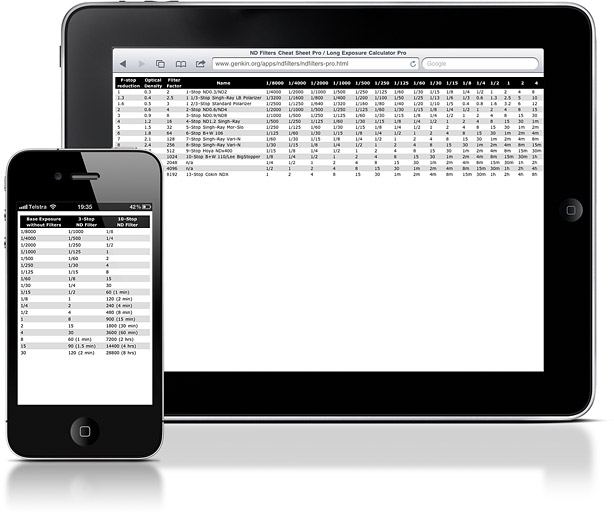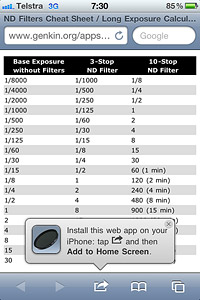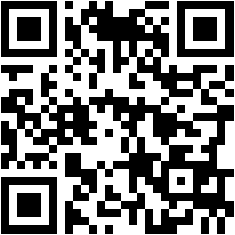ND Filters Long Exposure Quick Reference Charts and Cheat Sheets

Choosing the right exposure time when using ND filters like Lee Big Stopper or when stacking a couple of filters can be difficult sometimes. For years I was using a piece of paper with a ND filters cheat sheet that I kept in my wallet. Now we are using mobile devices more and more in our photography life so I created a mobile application - an electronic version of my ND filters cheat sheet (or long exposure calculator if you prefer) for mobile devices like Apple iPhone, iPad, iPod touch and Android devices.
I've got two versions of the neutral density reference charts to assist you in calculating exposure times when shooting with ND filters: 'lite' and 'pro' versions. They all are free. Yes, even the pro version is free. Personally I'm using the lite versions and not the pro one. These lite versions of the long exposure calculators are exactly what I had on a paper in my wallet. They are designed for using with one or two ND filters only as most of the time photographers are using maximum one or two 'favourite' filters in photography. I created a few versions of 'lite' calculators for most common combitations: 3- and 10-Stops ND filters, 6- and 10-Stops ND filters and just for 10-Stops ND filter like Lee BigStopper or B+W 110.
There is much confusion about numbers for ND filters. Some manufacturers specify filter numbers in F-stop reduction, other manufacturers specify filter numbers in optical density and third manufacturers specify filter numbers in filter factor. Just to clarify it a bit here is a simple reminder:
- 3-stop filter also could be referred as ND8 (optical density) or ND0.9 (filter factor).
- 6-stop filter also could be referred as ND64 (optical density) or ND1.8 (filter factor) or B+W 1.8 ND 106 or simply B+W 106.
- 10-stop filter also could be referred as ND1024 or ND1000 (optical density) or ND3.0 (filter factor) or or 3.0 ND 110 or B+W 110 or Lee BigStopper.
If you are using other ND filters like 5-stops Singh-Ray Mor-Slo or Singh-Ray Vari-ND/-Duo/-Trio filters you need to use the 'pro' version of the calculator. The 'pro' calculator also has a chart with all F-stop reductions, optical density and filter factors so you can easily find an equivalent to any filter. For example look at the chart and you'll see that 2 stops filter is ND4 and had 0.6 optical density. Same applies to any other filter.
How to use calculators? It's very simple.
First of all visit the following links using your mobile device or use QR-codes at the bottom of the page to access the links:
- ND8 & 10 Stop ND filters Long Exposure Calculator
- ND64 & 10 Stop ND filters Long Exposure Calculator
- 10 Stop ND filter Long Exposure Calculator
- ND Filters Long Exposure Calculator Pro
When you first access ND Filters Cheat Sheet from your Apple iPhone, iPad and iPod touch it will ask you if you want to 'Add to Home Screen' doing so will turn ND Filters Cheat Sheet into a Mobile App for you. On Android or other mobile devices you have to add bookmarks by yourself. For the first time you need an Internet connection, but after the first visit it is cached on your mobile device and will be available even without Internet.

Do a light metering with your camera without the ND filter. Set your camera to aperture priority, select the aperture you want to use and take a note of the shutter speed.
For one- or two-filters 'lite' calcs find the closest shutter speed to your reading in the left hand column and then read across to column which has the amount of ND filtration you are using ND8/ND64 or Lee Big Stopper - this gives you your exposure length.
For the 'PRO' calc find the closest shutter speed to your reading in the table header and then go down the number of stops that your ND filter filters. For the convenience on the left hand side of the table you can find your filter names.
Bear in mind all charts use full stops so if your shutter speed is a fraction of a full stop then you need to adjust it accordingly. However on really long exposures slight variations do not affect the exposure that much so you can use the closest value from the charts.
If you prefer to use non-electronic versions you can also print the charts out and laminate them to keep in your camera bag for reference.
In theory these charts should give you accurate exposure. However that's not always true with very dark filters and very long exposures. For the ND filters up to 5- or 6-stops these charts works perfectly but the darker the ND filter, the less reliable these charts get. For example, if my camera calculates an exposure of 1/60 without my 3- and 10-stops stacked ND filters, I would need to use an exposure of 2 minutes with two stacked filter. This is true in theory, but doesn't always quite work out right in real life. If I expose at 2 minutes, the image will be very underexposed. So I recommend going 2 or even 3 stops further, using 4 or 8 minutes of exposure time. I'm not sure why the 2 minutes don't produce the correct exposure, but I suspect we have two possible scenarios (or both of them). First of all manufacturers aren't that precise when describing the filter factor of their ND filters, especially when the filter factor gets big. A manufacturer could say that their 9-stop filter has a filter factor of five hundred twelve or five hundred or simply four hundred. The second possible option could be due to some kind of digital equivalent to 'reciprocity failure', which is a phenomenon experienced when shooting extra long exposures with film. The reason for such reciprocity failure with film is that the longer the exposure, the less effective the film is in recording the light and so the exposure length needs to be increased. Taking into account both possible options I simply increase exposure to be 2 or even 3 stops longer.
If you like these free ND filters long exposure calculators and cheat sheets you can also check my Long Exposure Calculators for iPhone and iPad which is a collection of different calculators (including the above ND Filters cheat sheets) created to help photographer with shooting long exposures with Neutral Density (ND) filters, in low light and at night. The app will help you with stacking Neutral Density filters, with shooting flowing water and fireworks or with calculating exposure under Moonlight or for shooting star-trails and still/non-moving stars. It also has a lot of links to useful resources on low-light and night photography, iPhone apps and books.
About the Artist
I'm Ilya Genkin - an internationally recognised Australian landscape and fine art photographer based in Sydney. My passion for capturing the beauty of nature and our world translates into striking photographic prints that bring life, emotion, and inspiration to any space. From tranquil seascapes to dramatic mountainscapes, each image is a reflection of my vision and dedication to the art of photography.
Fine Art Landscape Photography Prints
Explore my extensive collection of fine art prints - crafted with the highest-quality materials to suit every style and budget. Whether you're looking for a luxurious, ready-to-hang piece or a beautifully printed work to frame yourself, each photograph is available in several premium formats: Gallery-quality Fine Art Paper Prints - ready for framing, and Professional Canvas Prints - classic and timeless texture.
Each artwork is meticulously printed and made-to-order to ensure you receive a piece that elevates your home, office, or commercial space.
Artworks for Interior Designers, Home Stylists, and Architects
I collaborate with interior designers, home stylists, and architects to create bespoke wall art tailored to your project's aesthetic and colour palette. Prints can be customised and sized to complement your space perfectly. All pieces are made-to-order, and pricing varies based on size, quantity, and shipping.
Contact me to discuss your project and request a personalised quote.
Why Choose Ilya Genkin Photography?
By choosing my work, you're not just acquiring exceptional art - you're supporting an independent Australian artist and contributing to a vibrant local creative community. Every purchase directly helps sustain and grow this craft, bringing authentic and meaningful art into your life.
Request a free mockup to see how a chosen photograph will look in your space before you buy.
Start your journey today - browse the galleries and transform your walls with fine art photography.
Fine Art Landscape Photography
Information
Photography Guides
Online Store Opens 24/7
Email:
Phone: +61 (0) 421 055 613
Crafted with care for the planet - using sustainable materials and eco-friendly packaging.
Ilya Genkin Photography acknowledges the Traditional Custodians of the land on which we operate, live and gather as employees, and recognise their continuing connection to land, water and community. We pay respect to Elders past, present and emerging.


